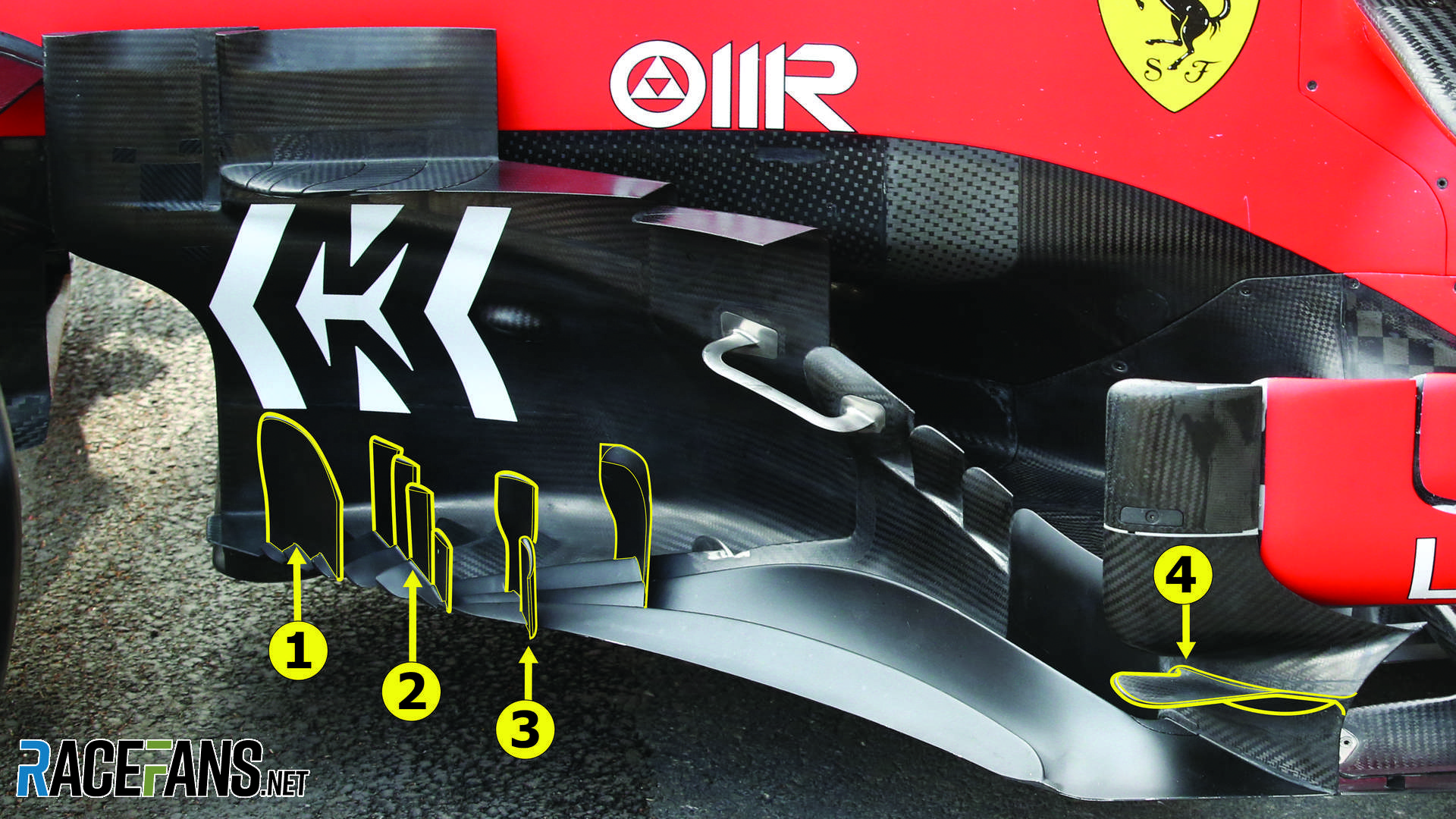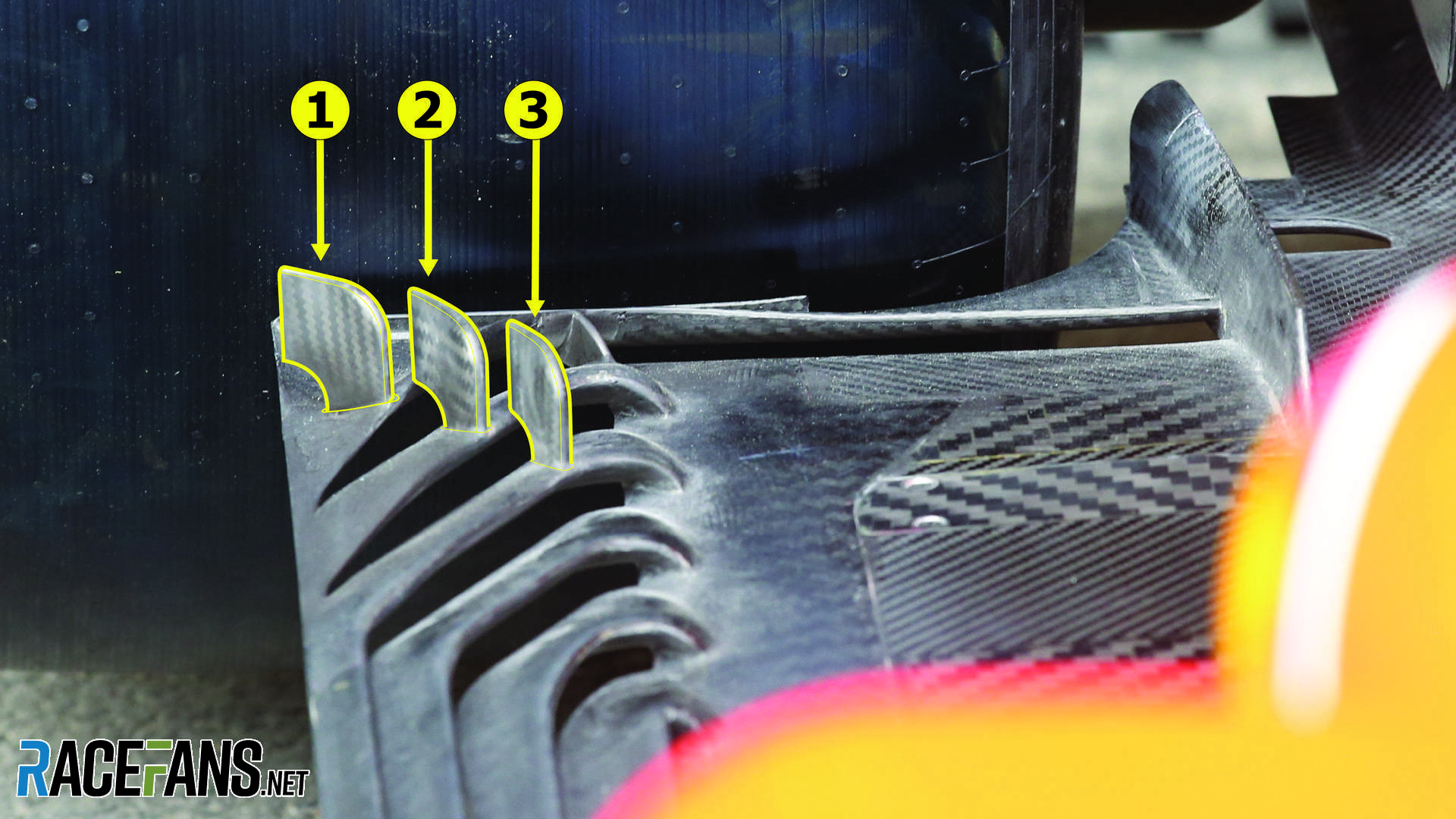Ahead of the Azerbaijan Grand Prix Ferrari team principal Mattia Binotto raised expectations of the team’s performance by revealing it would bring its first significant upgrade for the SF90.
The team emerged from pre-season testing looking strong, but in first three races Ferrari have flattered to deceive. Having shown pace and balance around Barcelona, the SF90 has since exhibited problems with low-speed understeer, fast-corner grip and power unit reliability.Despite this the car has shown little in the way of visible updates, only the revised Control Electronics being fitted to correct the short circuit which cost Charles Leclerc victory in Bahrain. The chassis updates predicted for Baku may have been expected to be significant, but what has been seen so far is a series of minor modifications to existing parts, allied to a race-specific low-drag rear wing.
What can be seen on the car, as it was presented to scrutineering, was a collection of interrelated updates from the front turning vanes, back to the bargeboards, floor edge and ending at the diffuser. There may be more updates yet to be seen on the car, other aero changes which are less visible and changes to the car under the skin. But this update package is not necessarily the cure to the Ferrari’s handling deficiencies.
The update does not have any major new parts or changes concepts, indicating this is more likely to be a package developed and signed-off early season which has only now been manufactured and brought to the track.

In detail the new package starts with the front turning vanes mounted under the nose, with subtle variations in the leading edges of the hanging vanes.
Advert | Become a RaceFans supporter and

The bargeboards equally have had updates, the vertical vanes mounted on the footplate section of the set up are different. Not necessarily more complex as the front row of three vanes (1) has been replaced with a single larger vane, while the intermediate vanes (2 and 3) are multiplied in number. Additionally, there is a dive plane (4) added to the bottom of the stack of sidepod mounted vanes.

Along the floor edge a series of three small vertical vanes have been added to the area ahead of the rear tyres. Then at the back of the car, the complex vanes on the outer corner of the diffuser are updated, in shape rather than number.
These updates need to be considered as a package, so their effect is likely to be greater than the benefit of the individual parts. Despite the apparent disparate nature of their positioning, they are all working with the same airflow, the Y250 airflow kicked up by the front wing.
The front turning vanes will help increase the power the Y250 vortex, as will be the numerous bargeboard vanes and the floor edge fins. This leaves only the diffuser treatment sitting out of the Y250 airflow which is directed outboard of the rear tyres.
Thus, they can be summarised as aero efficiency changes: they will not add downforce directly to the car, but will improve the aerodynamic efficiency at the rear of the SF90. This improvement in the trade-off between lift and drag means Ferrari could run more downforce for the same top speed or conversely run more top speed for the same downforce level.
It could be argued the potential to run more downforce will aid Ferrari’s ailments, but it’s doubtful these changes are of the order required to reverse the car’s current performance deficit to Mercedes.
Advert | Become a RaceFans supporter and
2019 F1 season
- Crying in the Melbourne car park at 2019 grand prix was my career low – Ocon
- McLaren Racing reports reduced £71 million loss in 2019
- Kvyat: Hockenheim podium last year was “my biggest achievement” so far
- How the FIA’s new encrypted fuel flow meter targets Ferrari’s suspected ‘aliasing’ trick
- “He smashed my office door”: 23 must-see moments from ‘Drive to Survive’ season two




Chaitanya
26th April 2019, 8:59
Mercs also have brought updates to their car, seems like for last decade or so this Red team is the biggest loser of cat and mouse game of development with its rivals.
GeeMac (@geemac)
26th April 2019, 9:29
Is there any reason why there is a lighter square of carbon between the IIR and Ferrari logos on the side of the chassis? Is that just a trick of the light?
Jeanrien (@jeanrien)
26th April 2019, 10:07
@geemac If you look closely there are 3 types of patterns there (left of lighter area, light area and right). It probably indicates that the material change for properties reason probably.
Really love those articles and that they come so quickly after the changes has been spotted. It allows us to better understand the flow around the car and potential impact of small modification. Keep it up Craig.
Craig Scarborough (@scarbs)
26th April 2019, 17:42
The woven material on the left is the nylon anti intrusion panel, as demanded by the regs
papaya
26th April 2019, 10:00
One of these 2 teams will show monster domination at this track, unlikely to be close racing. Question and bet: which team?
Tenerifeman (@tenerifeman)
26th April 2019, 14:13
I really admire the skill in spotting such small detail changes, is it sheer memory power (remembering the subtle shapes of 10 different cars) or do teams issue a helping guide?
Craig Scarborough (@scarbs)
26th April 2019, 17:44
Its hard to explain, its largely memory, like recognising someone having a different hair cut. The teams never help in pointing them out !
Adub Smallblock
26th April 2019, 14:35
Craig, I am really impressed with your ability to spot/note these differences. Do you keep a file of photos of each car’s details and compare, or just how the heck do you do this?
Craig Scarborough (@scarbs)
26th April 2019, 17:45
Its mainly memory. Some smaller features you need to cross check with older photos.
DaveW (@dmw)
26th April 2019, 14:52
What is with that odd-looking metallic “handle” on the bargeboards? One often sees parts connecting other parts for legality purposes, e.g. to cover a gap that would be seen from some angle specified in the rules, but this one seems like a rather strange and non-aero shape to put in in such an aerodynamically sensitive areas.
Craig Scarborough (@scarbs)
26th April 2019, 17:48
It’s a gap separator. To ensure the relative position of the bargeboards remain at the ideal distance. Its spaced so far from the vanes to prevent it blocking the airflow. Plus, it also gets used as an aerodynamic vane in it’s own right.
Alonso (@alonshow)
27th April 2019, 1:12
Such a waste of money and resources. As long as teams are allowed to spend millions in researching this kind of complex and pointless improvements, it will be impossible to bridge the gap between Formula 1 and Formula 1.5.